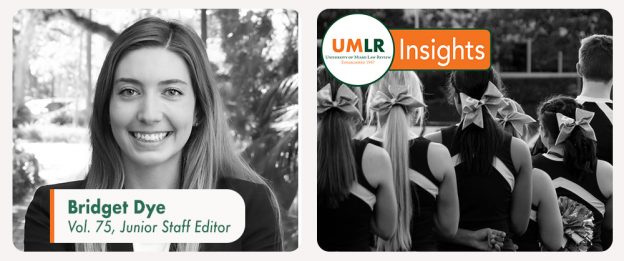BRIDGET DYE—The Supreme Court will soon consider the role social media plays in a student’s right to free speech in public schools. The Court has agreed to take up a Pennsylvania school district case, B.L. v. Mahanoy Area Sch. Dist., where a high school cheerleader was disciplined and suspended from the team after posting obscenities about the cheer program to social media.
The high school sophomore was disappointed when she failed to make the varsity cheerleading team, instead only making junior varsity. The student responded by posting twice on Snapchat. First, she posted a picture of herself and a friend with their middle fingers raised, captioned “F*ck school f*ck softball f*ck cheer f*ck everything.” Later, she sent just the text, “Love how me and [another student] got told we need a year of jv before we make varsity but that[] doesn’t matter to anyone else? 🙃”
The cheerleader made the post on a Saturday to an audience of about 250 Snapchat friends. A fellow cheerleader took screenshots of the posts and sent them to the school’s cheerleading coaches, who also heard about the messages from other cheerleaders and students. Over the next week, the posts caused disruption in school. Other students were “visibly upset” for several days and expressed concerns about the sophomore returning to the team.
The coaches determined that the cheerleader violated team rules of showing respect for the school, coaches, and other cheerleaders. Additionally, they determined that she violated the rules regarding refraining from posting negative information about the cheer program online, along with violating a school rule requiring student athletes to conduct themselves in a way that would not tarnish the image of the school district. The coaches removed her from the team for the year, stating that she could try out again next year. School authorities backed the coaches’ decision when the cheerleader and her parents tried to appeal. Ultimately, the teenager’s snapchat story would set in motion a significant Supreme Court case.
The District Court found that the school violated the cheerleader’s First Amendment rights, and the U.S. Court of Appeals for the Third Circuit affirmed the lower court. While acknowledging the “snap was crude, rude, and juvenile, just as we might expect of an adolescent,” the Third Circuit held that school administrators should not have “the power to quash student expression deemed crude or offensive—which far too easily metastasizes into the power to censor valuable speech and legitimate criticism.”
The Third Circuit relied on the Supreme Court’s Tinker v. Des Moines Indep. Cmty. Sch. Dist. (1969), which stated that students do not “shed their constitutional rights to freedom of speech or expression at the schoolhouse gate.” Tinker, however, allowed for an exception to the broad student free speech rights it upheld, which allows school officials to regulate speech that “would materially and substantially interfere with the requirements of appropriate discipline in the operation of the school.” To qualify for this exception, a school must show “a specific and significant fear of disruption” in order to prohibit student speech.
The Third Circuit decided that the snap was “off-campus” speech; a student’s online speech is not “on-campus” simply because it involves the school, is accessible to students, or reaches the school environment. The court acknowledged that while the boundary is not limited to the bricks and mortar of the school yard, limits do exist. The cheerleader in B.L. is far from the first student to get in trouble for what she posted online about school and will not be the last. As social media and online communications become more omnipresent in the lives of students, school administrators and courts will continue to struggle to draw the line between on- and off-campus speech. The Supreme Court has not yet addressed the on- and off-campus divide in the context of online speech, but many other cases have laid the groundwork for the Court to rule on the issue in B.L.
The American Federation of Teachers and other advocacy groups are urging the Supreme Court to overturn the Third Circuit’s ruling. They believe the ruling creates a circuit split as to whether, and to what extent, administrators may regulate off-campus student speech. Several states within the Third Circuit passed laws requiring schools to address off-campus cyberbullying or harassment with a close nexus to the school. The groups believe that the court drew an outdated line in today’s social media age, “when students can disrupt the school community from anywhere with the touch of a button.”
In its brief to the Court, the school district insisted that “the question presented recurs constantly and has become even more urgent as COVID-19 has forced schools to operate online.” The existing inconsistencies among the circuits reveal how hard it has become to draw the line between overreach and protecting the school environment in the era of social media.






